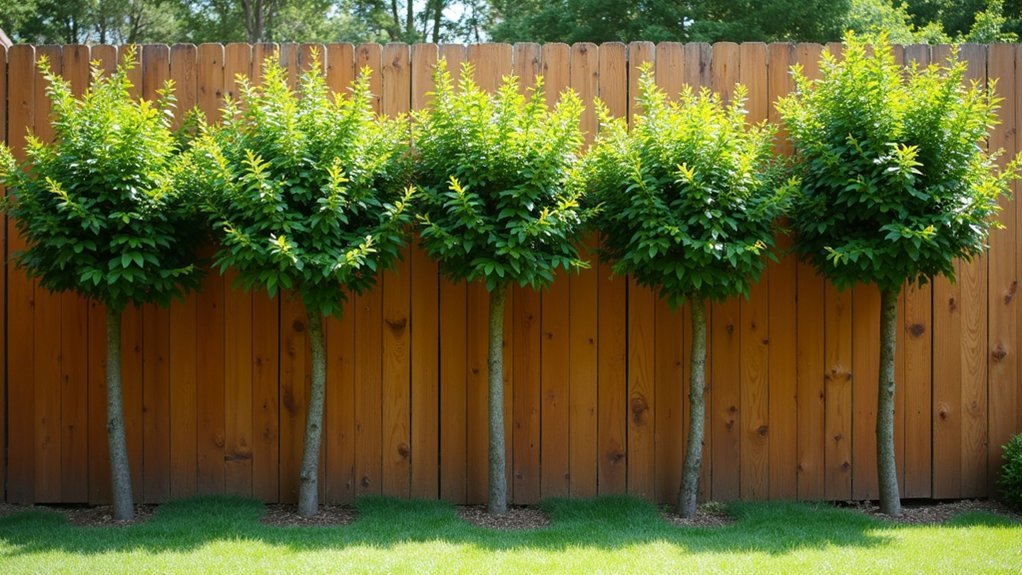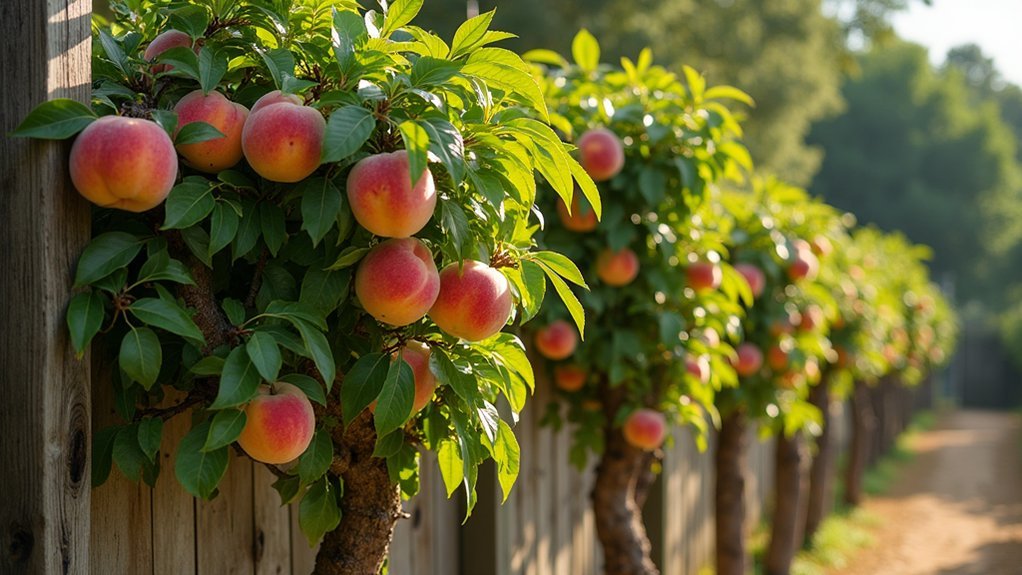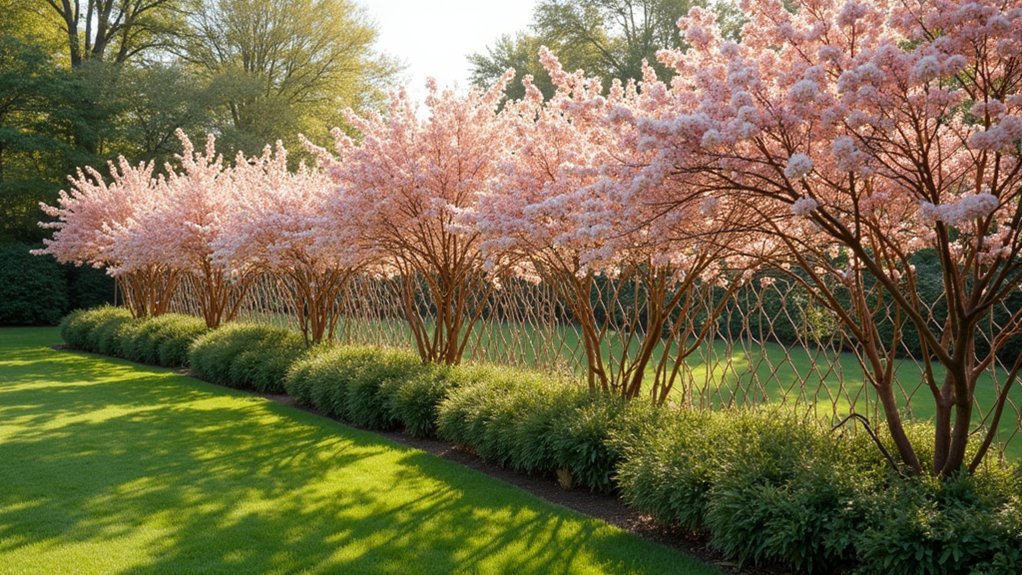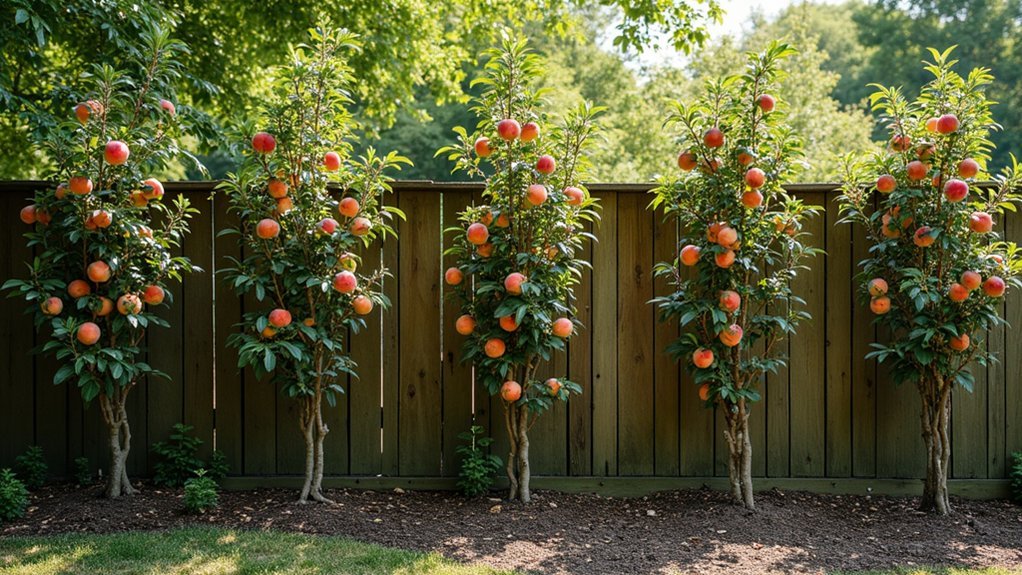Create beautiful living privacy screens with peach espalier designs. You can choose from the classic fan pattern, the interweaving Belgian fence, a three-tier horizontal cordon, the space-saving Palmette Verrier, or a flowing informal wave pattern. Each design combines functionality with visual appeal, offering both privacy and abundant fruit harvests. These living fences transform ordinary boundaries while maximizing sunlight exposure and air circulation. Discover which espalier technique will best suit your garden space.
The Classic Fan Pattern: Creating Privacy With Elegant Simplicity

Artistry meets functionality in the Classic Fan pattern, perhaps the most graceful of all peach espalier designs.
You’ll create a living privacy screen as branches radiate outward like nature’s own lattice, secured to supporting wires or trellis structures.
This pattern isn’t just about aesthetics—it’s engineered for peak growing conditions. The fan configuration maximizes sunlight exposure and promotes excellent air circulation around your peach trees, resulting in healthier growth and more abundant fruit.
You’ll need to regularly prune and train the branches to maintain the distinctive fan shape. This disciplined approach directs energy to fruit-bearing shoots while eliminating unwanted growth.
Your reward? An elegant boundary that transforms your garden space while providing delicious harvests right outside your door.
Belgian Fence Design: Interweaving Peach Varieties for a Living Screen
While the Classic Fan pattern offers elegant simplicity, the Belgian Fence design elevates your espalier project to new heights of sophistication and productivity. You’ll create a stunning living screen by interweaving up to nine different varieties of peaches within just 20 feet.
| Structure Elements | Benefits |
|---|---|
| Vertical wires | Support growth |
| Horizontal wires | Guide branches |
| Angled branches | Maximize sunlight |
| Pruned segments | Control vigor |
The key to success lies in how branches are pruned back seasonally. As different varieties grow at varying rates, regular maintenance guarantees each remains in its designated space. This technique not only provides privacy but transforms your garden boundary into a productive, visually striking feature where branches crisscross to form an elegant lattice pattern.
Three-Tier Horizontal Cordon: Maximizing Privacy and Fruit Production

When space efficiency meets elegant design, the Three-Tier Horizontal Cordon stands out as one of the most practical espalier patterns for peach growers. This system features three parallel layers spaced 12-18 inches apart, creating an effective privacy barrier while optimizing fruit production.
You’ll need to establish a robust support structure with wires or trellises to maintain the distinctive horizontal branches. Regular pruning keeps branches growing laterally and prevents overcrowding, encouraging healthy fruit-bearing wood.
The design’s openness also simplifies pest management by improving visibility and air circulation.
What makes the three-tier horizontal cordon particularly valuable is its versatility—you can grow different peach varieties on the same structure, enhancing your garden’s biodiversity while maintaining an attractive, organized appearance.
The result is a space-saving solution that delivers impressive yields in compact areas.
Palmette Verrier: A Vertical Privacy Solution for Narrow Spaces
For gardeners with limited horizontal space, the Palmette Verrier espalier design offers an elegant vertical solution. This style features graceful upward-growing branches that create both privacy and fruit production potential in tight areas. You’ll need to establish a sturdy support structure using posts and wires to guide growth into the distinctive vertical pattern.
| Season | Maintenance Task |
|---|---|
| Spring | Train new growth upward |
| Summer | Thin excess fruit |
| Fall | Cutting back lateral branches |
| Winter | Prune to maintain form |
Regular pruning is essential to maintain the vertical alignment and guarantee proper air circulation. By carefully training your peach tree in this pattern, you’ll successfully grow fruit trees that serve as beautiful privacy screens while maximizing production in narrow garden spaces.
Informal Wave Pattern: A Flowing Natural Barrier of Peach Blossoms

Gardeners seeking a more natural aesthetic will find the Informal Wave Pattern espalier design perfectly balances structure with organic beauty.
Unlike rigid formal designs, this approach allows you to train branches in gentle, flowing curves that mimic natural landscapes while providing privacy through lush foliage.
Select dwarf or semi-dwarf peach varieties for easier management while keeping the tree at an ideal height for maintenance and harvest.
The wave pattern’s organic form encourages proper air circulation and sunlight exposure, promoting healthy new growth and abundant flowering.
You’ll need to prune regularly to maintain the flowing silhouette, directing branches along your desired wave pattern.
This relaxed approach not only creates a stunning visual barrier but also optimizes growing conditions for fragrant blossoms and delicious fruits.
Frequently Asked Questions
Can Peach Trees Be Espaliered?
Yes, you can definitely espalier peach trees. They’re well-suited for this training method, especially varieties like ‘Elberta’ and ‘Redhaven’ with flexible branches. You’ll need regular pruning to maintain their decorative shape.
What Not to Plant Next to Fruit Trees?
Don’t plant heavy feeders like corn or tomatoes, nightshades that harbor diseases, invasive species like mint, plants with different watering needs, or strong-scented herbs that might deter pollinators near your fruit trees.
What Is the Spacing for Espalier Posts?
You’ll want to space espalier posts 10-15 feet apart. Install the first wire 2 feet above ground, then place additional wires at 12-inch intervals. This spacing provides proper support for your trained fruit trees.
What Is the Easiest Fruit Tree to Espalier?
Peach trees are your easiest espalier option. You’ll find their flexible branches and vigorous growth perfect for training into shapes. They’re forgiving for beginners and adapt well to fan styles with minimal effort.
In Summary
You’ve now discovered five stunning peach espalier fence designs that blend functionality with beauty. Whether you choose the classic fan, Belgian weave, horizontal cordon, palmette verrier, or wave pattern, you’ll enjoy both privacy and delicious harvests. Don’t hesitate to adapt these designs to your specific space and needs. With patience and proper pruning, your living peach fence will become a mesmerizing focal point in your garden.





Leave a Reply